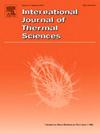Performance improvement of wavy-plate heat exchanger by vortex generators with adjacent-reverse arrangement
IF 4.9
2区 工程技术
Q1 ENGINEERING, MECHANICAL
International Journal of Thermal Sciences
Pub Date : 2025-05-09
DOI:10.1016/j.ijthermalsci.2025.109982
引用次数: 0
Abstract
The installation of vortex generators on the heat transfer surface is an effective method for enhancing heat transfer. In this study, a novel arrangement of vortex generators with an adjacent-reverse arrangement on the bottom wall is investigated for wavy fin channel. Configurations of vortex generators with different attack angles are numerically compared. Moreover, the performance of the studied arrangement is compared with that of the normal arrangement in the literature. The results indicate that longitudinal vortices generated by vortex generators with an adjacent-reverse arrangement are more effective at disrupting fluid flow and, consequently, heat transfer improvement. The Nusslet number increases and then decreases with the increase in attack angles, with increments occurring every 15° from 15° to 75°. The Nusselt number of the studied wavy channel increases by 16.6 %–40.5 % for various attack angles compared with the smooth wavy channel, while the friction factor only increases by 7.5 %–30.3 %. Through coupled evaluation of heat transfer and pressure loss characteristics, the 60° attack angle demonstrates optimal performance, achieving a maximum thermal performance factor of 1.29. This value represents a 29 % enhancement compared with the smooth wavy channel. Furthermore, the studied configuration achieves a 5.1 % enhancement compared with the normal setup of vortex generators aligned in the same direction as found in the literature.
邻接反排涡发生器对波板换热器性能的改善
在换热表面安装涡发生器是一种有效的强化换热的方法。本文研究了一种新的波浪鳍形通道底壁上的邻接-反向涡发生器布置方式。对不同攻角涡发生器的结构进行了数值比较。此外,还将所研究的排列与文献中正常排列的性能进行了比较。结果表明,相邻反排涡发生器产生的纵向涡能更有效地破坏流体流动,从而改善换热。随着攻角的增加,努斯莱特数先增加后减少,从15°到75°每15°增加一次。在不同攻角下,与光滑波状通道相比,波状通道的努塞尔数增加了16.6% ~ 40.5%,而摩擦系数仅增加了7.5% ~ 30.3%。通过对传热和压力损失特性的耦合评估,60°攻角表现出最佳性能,热性能因子最大为1.29。与平滑的波浪通道相比,该值代表了29%的增强。此外,与文献中发现的沿同一方向排列的涡旋发生器的正常设置相比,所研究的配置实现了5.1%的增强。
本文章由计算机程序翻译,如有差异,请以英文原文为准。
求助全文
约1分钟内获得全文
求助全文
来源期刊

International Journal of Thermal Sciences
工程技术-工程:机械
CiteScore
8.10
自引率
11.10%
发文量
531
审稿时长
55 days
期刊介绍:
The International Journal of Thermal Sciences is a journal devoted to the publication of fundamental studies on the physics of transfer processes in general, with an emphasis on thermal aspects and also applied research on various processes, energy systems and the environment. Articles are published in English and French, and are subject to peer review.
The fundamental subjects considered within the scope of the journal are:
* Heat and relevant mass transfer at all scales (nano, micro and macro) and in all types of material (heterogeneous, composites, biological,...) and fluid flow
* Forced, natural or mixed convection in reactive or non-reactive media
* Single or multi–phase fluid flow with or without phase change
* Near–and far–field radiative heat transfer
* Combined modes of heat transfer in complex systems (for example, plasmas, biological, geological,...)
* Multiscale modelling
The applied research topics include:
* Heat exchangers, heat pipes, cooling processes
* Transport phenomena taking place in industrial processes (chemical, food and agricultural, metallurgical, space and aeronautical, automobile industries)
* Nano–and micro–technology for energy, space, biosystems and devices
* Heat transport analysis in advanced systems
* Impact of energy–related processes on environment, and emerging energy systems
The study of thermophysical properties of materials and fluids, thermal measurement techniques, inverse methods, and the developments of experimental methods are within the scope of the International Journal of Thermal Sciences which also covers the modelling, and numerical methods applied to thermal transfer.
 求助内容:
求助内容: 应助结果提醒方式:
应助结果提醒方式:


